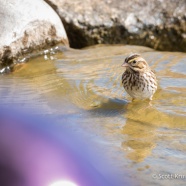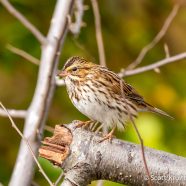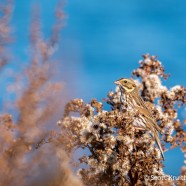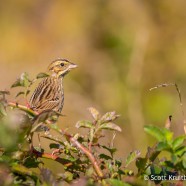Swimming Sparrow
Sparrow diversity will be increasing by the day as we move through October and the temperature finally drops. You can expect to see more familiar faces soon after cold fronts bring cooperative winds. In the mean time we have plenty of the more abundant birds like this Savannah Sparrow utilizing the grasslands, feed plots, gardens, dirt patches, rocks, and waterways of Chautauqua County. Scott Kruitbosch Conservation & Outreach Coordinator
Read MoreSavannah Sparrow
The Savannah Sparrow (Passerculus sandwichensis) is another bird pushing south through our grasslands, fields, and farms right now. Look for their brown streaks – likely more thin and broken up than the Song Sparrow – and the distinctive yellow patch of feathers over the eye extending to their small bill.
Read MoreSavannah Sparrow
This Savannah Sparrow is showing off some excellent fall and soon to be winter camouflage! Grasslands, fields, shrub and scrub, and beach habitats are some of the places to find them still moving through in late, small numbers, with others setting up their winter homes. Keep an eye out for the Ispwich Savannah Sparrow if you are on the Atlantic Coast. This subspecies of Savannah Sparrow breeds exclusively on Sable Island, Nova Scotia, and winters on similar sand dunes on the shoreline. It is noticeably paler and weighs approximately 50% more than most other Savannah Sparrow...
Read MoreLeucistic Savannah Sparrow
This appears to be a partially leucistic Savannah Sparrow, a migrant individual that I was surprised by yesterday morning. Leucism is when pigments are produced at less than normal levels or in an unexpected pattern. In this case many of the feathers on the head and throat do not have typical pigmentation. Interestingly the yellow patch on the face can still be seen, giving this unique bird an all the more fascinating look. Scott Kruitbosch Conservation & Outreach Coordinator
Read MoreSavannah Sparrow
Masses of Savannah Sparrows are still on the move right now, pushing through our fields, grasslands, shrublands, farmlands and other open areas with significant food supplies and enough room to hide. Autumn allows you to study so many individual birds that show us how much variance there can be within what we call a species.
Read More








